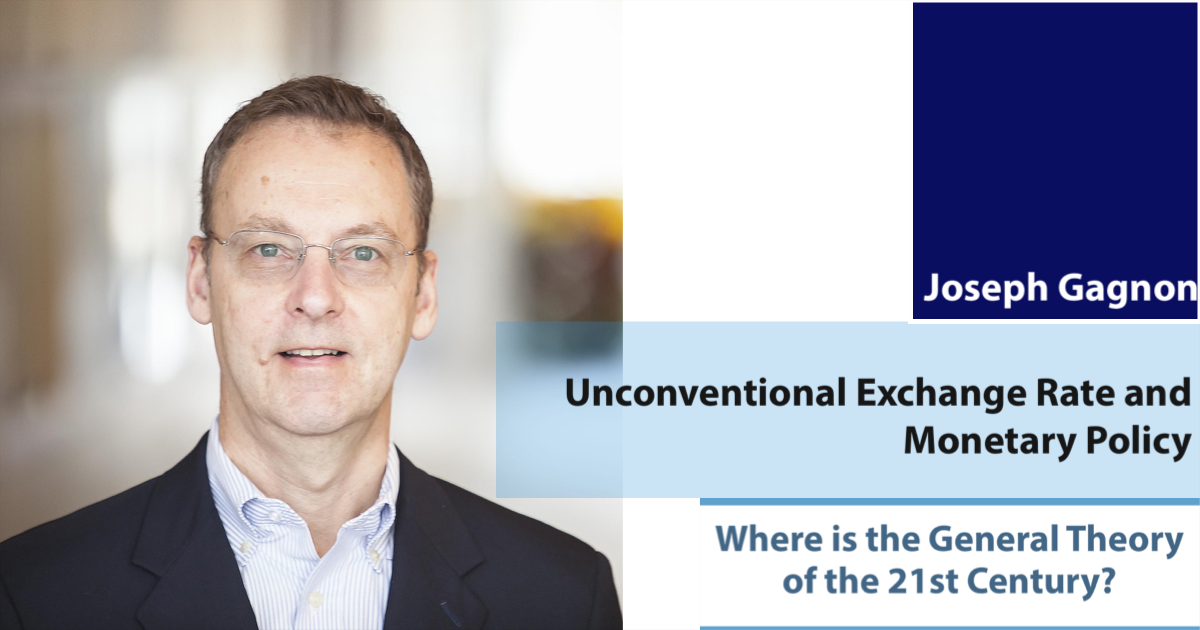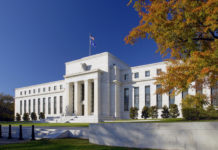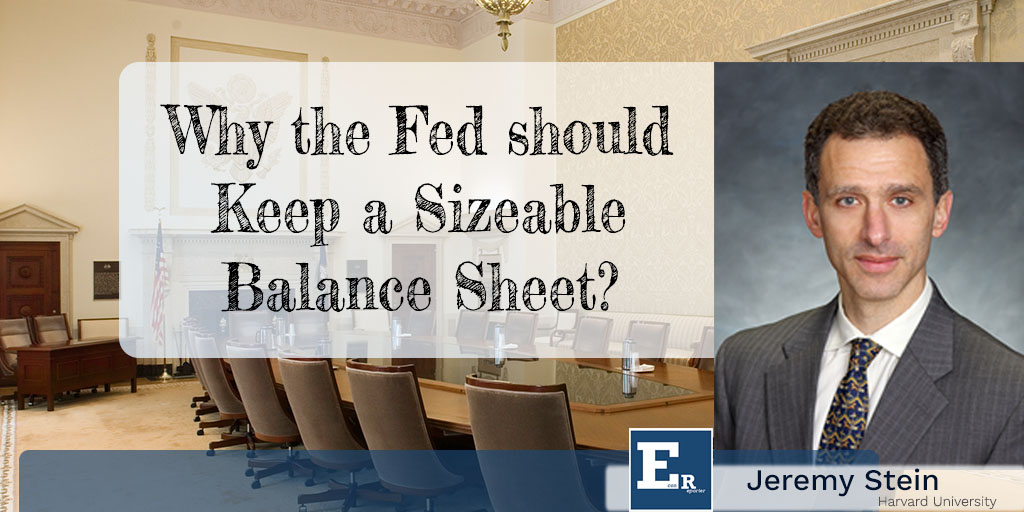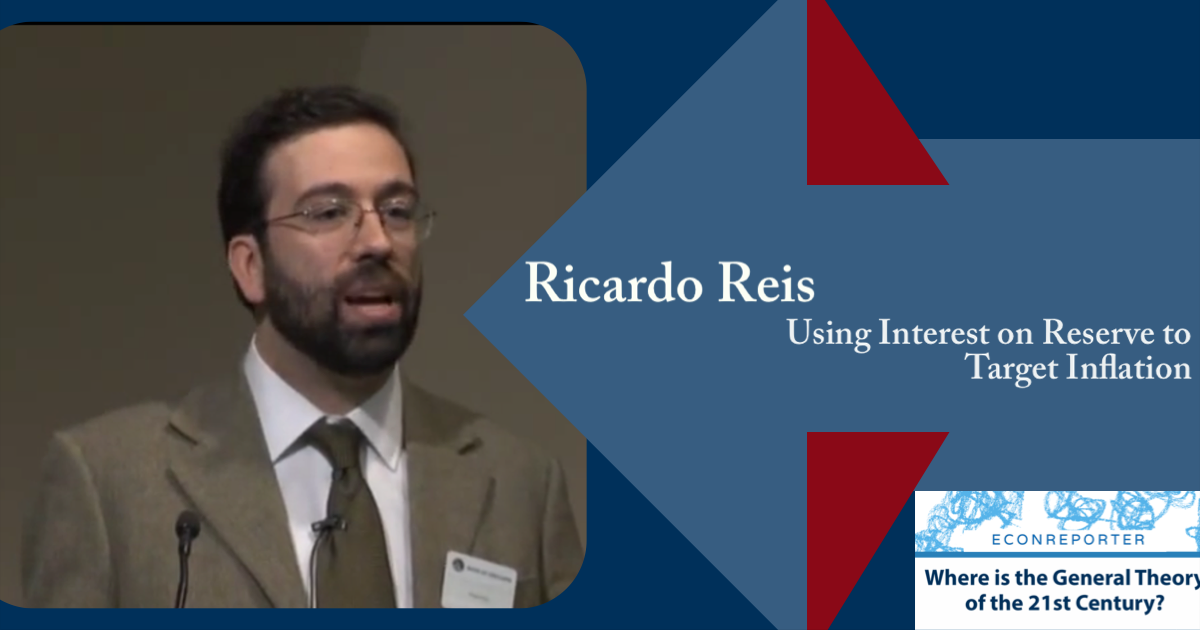This is the latest installment of our interview series “Where is the General Theory of the 21st Century?”. “Where is the General Theory of the 21st Century?” is an interview series that explore the evolution of macroeconomics academia since the Great Recession. Do we have some revolutionary changes in the macroeconomics after 2008, just like we had had the “Keynesian Revolution” after the Great Recession? Why haven’t economists come up with a new General Theory after the Great Recession? We ask influential economists for their answers on these questions.
The honorable guest for this installment is Joseph E. Gagnon, senior fellow at Peterson Institute for International Economics (PIIE). Gagnon was previously visiting associate director, Division of Monetary Affairs (2008–09) at the US Federal Reserve Board. He also served on the US Federal Reserve Board as associate director, Division of International Finance (1999–2008).
In this interview, we discussed one of his latest research paper “Unconventional Monetary and Exchange Rate Policies” and the new book he coauthored with C. Fred Bergsten, “Currency Conflict and Trade Policy: A New Strategy for the United States“. Gagnon also shared his view on the very popular “Global Financial Cycle” ideas.
(The interview is edited for clarity. All mistakes are ours.)
Photo Credit: PIIE
Q: EconReporter G: Gagnon
Q: I understand that “Unconventional Monetary and Exchange Rate Policies” is part of your research series about the effect of central bank foreign assets purchases on the current account. What is the motivation behind this research project?
G: This line of research started in 2010, I was asked to write a paper for the G20 meeting in Korea. The topic was “The G20’s Goal of Sustainable and Balanced Growth”. “Sustainable” means the growth is not too fast, or there is no big recession. But the growth needs to be “balanced” because we had had a very large current account imbalances. At the time, the imbalances were shrinking and they wanted it to continue. So, I was looking into what policies would be helpful.
I ran some regression and I found the literature that was started by Menzie Chinn and Eswar Prasad on explaining current account over the medium term. I liked it. I thought I would update their foundings and add more variables to see what happens. I found that the foreign exchange intervention was having apparently a bigger effect than I expected. So I pursued it further in a series of papers.
In the last couple of papers which I have written with Tamim Bayoumi and Christian Saborowski, we have tried to use some instrumental variables to try to control for the endogeneity of intervention because intervention can be endogenous.
The latest paper that you are talking about “Direct and Spillover Effects of Unconventional Monetary and Exchange Rate Policies” which is in the Open Economy Review, and also a working paper in the IMF and Federal Reserve. [Editor’s Note: The one I get from the Fed is called “Unconventional Monetary and Exchange Rate Policies”] I think that is the best one at least in terms of the current account annual regression. It’s a very complicated paper, unfortunately, we have got many parts that don’t fit together very well.
I will focus on the current account regression which is related to my earlier papers you’ve mentioned. This is the best one because it really shows how fiscal policy, energy export, demographic factors, trend growth rate and intervention policy all affect the current account. Also, it shows how the capital mobility, i.e. the restriction on capital flows, interacts with those in a very sensible way. These results are the best yet. The results are intuitive and they are very robust to a lot of different changes. You can change the country sample, the time sample and use different instruments. The result is pretty much robust.
Q: Your research found that the effect of an increase in net official flow on the current account would depend on the mobility of capital. Why would it be the case?
G: It would be helpful to think about two extreme cases. Suppose that the private sector was not allowed to borrow or lend. Capital restrictions are about what the private sector can do. If it is not allowed to borrow and lend, then the only way a country can have a current surplus or deficit is if the government is doing it. Foreign exchange intervention is the number one way the government can borrow and lend abroad.
By the way, we used something broader than just foreign exchange intervention and we called it Net Official Flow (NOF). The net official flow includes foreign exchange interventions and also Sovereign Wealth Fund (SWF) and official development loans. Foreign currency borrowing of governments which is like a negative intervention. Think about it, intervention is the government acquiring foreign assets. Development loans are the government acquiring a foreign liability, so we give the latter a minus sign. It turns out that if you just add those things up with the right signs, that is what a government borrows and lends abroad.
If you have a very restrictive law in capital mobility, that turns out to be the most important thing that affects the current account. The coefficient is about 0.7-0.75. That means that for every dollar the government invests abroad, the current account goes up by about 70 cents. That’s a very big effect.
Usually, it is the poor countries that have such restriction. China was close to that end of the spectrum for a long time and is slowly opening up, although they have some step back lately. It still has a pretty restrictive capital control, so they are closer to the 70 cents end of the spectrum. Maybe not quite that much, but still in that region.
Then if you go to the other end, which is a very open economy like Switzerland or Japan, then the coefficient is down to 0.2 – 0.3. It said that if the government spend a dollar on intervention, it raises your current account by 20 or 30 cents. It’s small.
I think if you look at those countries that make sense. You wouldn’t expect it to be zero. It would be zero only if markets are perfectly efficient and free. Even when they are free, they are not necessarily efficient. I think the Efficient Market Hypothesis is coming under question especially after the Financial Crisis. So, I don’t think we should expect it to be perfectly efficient.
The theory would be that in the efficient markets if the government takes capital from one market and moves it to another market, then the efficient market would say “Well, that’s a distortion. We didn’t want that capital to move in that direction. We will move it back.” The market would then undo what the government does. That’s the standard result in finance if the markets are efficient. The governments can’t have any effect. But I think they can have a small effect or modest effect.
One point I would add is about another big policy — the fiscal policy. We know that the fiscal policy should affect current imbalances. But we find a larger coefficient for the open economy than most other people. If you have an open capital market, we got a coefficient of 0.5; if you have a closed capital market, it is more like 0.1. That make a lot of sense. Fiscal policy should have an effect, and if the market is closed then it doesn’t because the capital is bottled-up.
The nice thing is that the sum of the two coefficients, the official flow and the fiscal policy, is very high regardless of the mobility. It is always about 0.8 and 0.9. What that said is that for countries which both have fiscal surpluses and intervened a lot, for example, Singapore or Norway, who got a big Sovereign Wealth Fund and the fiscal balance is basically all invested abroad. Regardless of the capital mobility, because of the combined effect of fiscal policy and intervention, their current account are almost one-for-one with their fiscal/intervention policy.
Q: It seems that foreign exchange intervention is an effective way to affect the current account of a country. As you have mentioned in a recent note for PIIE “The Unsustainable Trajectory of US International Debt”, the best way to reduce the US trade deficit is to devalue the US dollars. Does it mean that the US should buy foreign assets aggressively?
G: First of all, I don’t want to ignore fiscal policy. My work shows that the US fiscal policy has been a big cause for our trade deficit also. So let’s not forget that.
You asked about the dollar policy and currency intervention. I think that in the past the US could have done more, and maybe in the future, we could do more. We should think about it. It’s kind of awkward because if we have a fiscal policy that is not helping, and two policies operating at the opposite end is not good. So, my advice would be that we should have a smaller fiscal policy, not a larger one.
In the book I have with Fred Bergsten “Currency Conflict and Trade Policy: A New Strategy for the United States” which is coming out [The book is not available on Amazon, you can buy it here], we proposed the following.

We propose that the US should announce that the US will be on guard for future excessive intervention by the G20 countries. None of them are doing that right now and, in fact, China is doing the opposite. They have been selling dollar which is good to hold up their RMB. But if they start buying a lot of the dollars or other foreign currencies to hold their currency down when they have a big trade surplus, we would call that currency manipulation. If it exceeds a certain amount, which we described in the book, the US should step in and do the opposite, we can buy their currency. They can buy our currency, we can buy their currency. So, we should announce that.
It is a good time to do it because no one in the G20 is manipulating their currencies right now. It wouldn’t have an immediate effect but it would be a warning for the future. That’s what we say in the book.
Also, if the US make such statement it properly would push the dollar down immediately today because the value of the dollar is being held up now not only by the US economy being strong, which of course is important, but also because financial market participants know that if the dollar comes under pressure in the future, there are many other countries like China, Switzerland, Taiwan, Japan, and Korea, who will step in and buy the dollars if it is weakening as they don’t want their own currency to strengthen.
That is like a “Dollar Put”. You know the “Greenspan Put”? The Fed would ease if the stock market fell. Well, this is a “Currency Manipulation Put” on the dollar. If the dollar comes under weakening pressure, a lot of foreign governments would buy it. So, a lot of private market participants know that if they are holding the dollars, they can sell them into that “put” and won’t take a big loss. That reassurance is holding the dollar up right now. The dollar would probably fall a bit if the US could credibly prevent a future outbreak of currency manipulation.
But more broadly, we think that the IMF should really be thinking a lot more clearly about the intervention policy. Maybe they should encourage the countries with a large deficit to intervene and weaken their currency and encourage countries with large surpluses to intervene in the other direction.
Basically, because what matter is the large imbalances in the current account, and it often caused, or accompanied by, financial excesses, they are often not sustainable. They have to be reversed. They are costly. It is better if we keep them from being too big. Why not encourage everyone to do that? That would mean that if the US deficit got more than 3%, maybe the US should buy foreign currency. That is not our immediate concern, but it is a worry for the future.
If you want to know more about Gagnon and Bergsten’s new book, you might be interested in this book event by PIIE:
Book Launch: Currency Conflict and Trade Policy: A New Strategy for the United States
Q: If other central banks do the opposite when the US intervenes, would it be more difficult for the US to achieve its goal?
G: It would be unusual for the US to do it on its own. In the past, we usually do it in cooperation with other countries. I would think that it should be in cooperation. It may not be possible to always do it in cooperation, though. For example, there is the issue of whose currencies we should buy.
Bergsten and I are not proposing this right away. I think, for now, all I would say is just do the countervailing currency manipulation if some other countries are intervening a lot to hold up the large surplus and we should offset that. Buy their currency to undo that effect.
As far as the US is doing that unilaterally because we have a deficit and buying foreign currency, I am not sure we are ready to do that yet. But it is something we should talk about. I mean, it is nice for the IMF to talk about what should the countries do when they have large deficits and surpluses. I think maybe the best answer would be… well… we could have a Plaza Agreement.
We had a Plaza Agreement in 1985. Part of the agreement was that we sold the dollar and bought foreign currencies to push the dollar down. Other countries agreed with us and they did it too. We also have to agree to cut our fiscal deficit. That was part of the deal. People forget that but it is part of the deal. Maybe that would be part of the deal again that to reverse the fiscal course, given our fiscal deficit is looking to in the wrong direction. Get other countries to agree that if we reversed the fiscal deficit, then they will let us buy their currency.
Some kind of deal like that would be good. Maybe not today, cause the current account deficit is not dangerous right now. The US’s deficit is about 2.5%, so is China’s. That’s ok. But it is getting close to a danger zone. I think if they go above 3% we can start talking about it. It might well go above 3%. But for now, I would not worry, it is not the first thing.
Q: According to your research, the effect of quantitative easing (QE) on the current account is relatively small. Why?
G: People are surprised because QE does have an effect on the exchange rate. If it affects the exchange rate, then you might think it should also affect the trade balance. But what they forget is that QE has an opposing effect on domestic consumption.
When the US does QE the dollar depreciates, which helps its export. But QE encourages consumption and investment inside the US, which sucks in imports. That’s going the other way. As far as we could tell, those two effects roughly cancel out. It also seems to be true in Japan and the UK.
In the Euro Area, it is true that they are doing QE and their current account is going up. But I think that has more to do with the fiscal austerity than it does with the QE. So, I am not too surprised by that.
So, the two effects offset and that’s why QE is different from foreign exchange intervention. When you do foreign exchange intervention that also affects the exchange rate, but it doesn’t have any opposing effect on domestic consumption or investment. There is nothing to offset the exchange rate effect. That’s why intervention has a bigger effect on current accounts. That’s pretty strong in the data.
But I would add one point to link together my research under an overarching theme. It is that the financial markets are not efficient. If the financial markets were efficient, QE would not work and intervention would not work either because the financial market would undo what the government is doing. I think the financial market is not efficient, and that’s what my research shows.
In particular, it seems that the old idea of portfolio balance, the idea that the price of an asset may depend in part on the supply of that asset. It is a view that efficient market rejects. But this is an older view by James Tobin that portfolio should matter. That idea was before we have the efficient market theory and I think he was right. I think that supply does matter and governments have the ability to affect the supply.
Maybe they have to do a lot, you know… to intervene and affect the currency you have to buy hundreds of billion of dollars. You have to do that in large amounts. But it has some effect. That’s the unifying theme of my theory — portfolio balance, the James Tobin view of the world is right after all.
I haven’t written a paper that said that, but I should.
Q: Since 2008 there is a lots of works on the so-called “Global Financial Cycle” in the International Finance literature. Do you support this idea yourself?
G: On the “Global Financial Cycle” that Helene Rey proposed, I think the facts she presented are correct. She shows that the US sort of dominated the Global Financial Cycle and other countries move along with it. We don’t fully understand why that is. Like why the Euro Area, which is almost as big, and Japan, which is maybe a third as big, don’t have more impact. It is a puzzle.
One thing she said I don’t agree though. She shows that countries’ interest rates often follow the US’s and move with the US’s, even if those countries have a floating exchange rate. We know that if they have fixed exchange rate, they have to move with the US’s. But in the floating exchange rate, they don’t have to, or you would think they don’t have to. Then she shows that they do.
But then she jumps to the conclusion that those countries are forced to follow the US and they can’t control it. I think that is a wrong conclusion. If you look at Canada, it is a really good case. In Canada, about 25% of the GDP is exported to the US. They are more depended on the US economy than any other countries. Their financial system is completely open. The links between Canada and the US on trade and finance are deep. They have a floating exchange rate and independent monetary policy. If you look at their interest rate…Yes, it is correlated to the US interest rate. Of course, they would be because the same shock that affected the US is affecting Canada. When we boom, they boom, because they send exports to us.
But there are also enough differences. They don’t feel forced into following the US. The Bank of Canada often wants to do the same thing as the Fed, but it doesn’t have to. Oil prices is particularly a source of differences. The differences between Canada and the US is that they have oil and we don’t. Although that is changing, basically until now we are the oil importer and Canada is the exporter. They have enough ability to widen or narrow the spread of interest rate against the US as needed to offset the oil effect. They have better macro stability. Their unemployment fluctuation and inflation fluctuation are smaller. Even though they are a commodity country that should be volatile, their government has stabilized the country better than the US.
So the whole idea that the US is forcing countries to have policies that are not good for them is wrong. There is some correlation. But it could still be optimal. Countries could be free to choose what they want.
The Canadian feel that they can have an independent monetary policy and they used it well. Some countries might move with the US but they shouldn’t. Maybe they should let their exchange rate move more. There are lots of fear of floating, as there are lots what the countries don’t like when their currencies move. So they move their interest rate to keep that from happening. They are actually mimicking the US even when they shouldn’t.
So, I think Helene Rey’s facts are correct when she points out an interesting fact that is correct. But the conclusion she draws, I don’t agree with. Just because countries do something it doesn’t mean it is optimal and necessary.
Q: My last question would be on the international dimension of monetary policy. It seems to me that you think other central banks do have a choice on their monetary policies, regardless of what the Fed does. Am I right?
G: I think central banks’ policies on foreign exchange are very different across countries and it’s interesting. Some countries are very activist. Some countries are not. Some countries let the central bank take the lead. Other countries let the finance ministry takes the lead. In exchange rate policies, you see quite a lot of differences also.
I think whoever take the lead, whether it is the central banks or the finance ministry, they have a lot of ability to affect the exchange rate. My view is that when they are buying foreign currencies, they should always have an eye to the current account imbalances. If you have a big surplus, you shouldn’t be buying more foreign exchange. If you have a big deficit, you shouldn’t be selling foreign exchange.
Very often countries do the opposite things, but they shouldn’t. Egypt has a big deficit and they were selling its foreign currencies. They shouldn’t have been doing that. They should have let their currency depreciates. China has a big surplus, but they were buying foreign exchange. They shouldn’t have been doing that. They should have let their currency appreciates. You should take a clue for your currency from your current account.
But I think all countries have domestic policy options too. They don’t have to operate on the foreign exchange. They can buy domestic bonds, not only government bonds but also domestic private bonds. They can lend money to the banks. One of the policies that don’t get talked about very much… QE gets a lot of attentions, but in the Euro Area and the UK, the central banks have implemented subsidized lending programs to the banks to stimulate the economy. Most people who studied it think it is a very effective policy. If you are a country that doesn’t have a big government bond market, that’s an alternative way of doing monetary policy.
So, I think all countries have tools inside their own countries. That doesn’t even require exchange rate or foreign currencies interventions. It could just be domestic monetary policy. I think they should be open to using them. That is why I think the Hong Kong case, back in the Asian Financial Crisis, is interesting because the HK government realized that they can buy stocks. It was like: “Wow! We never thought we could do this. But we could!” [Editor Note: Gagnon’s discussion on the Hong Kong Stock Market intervention in 1998 will soon be published in the second part of this interview.]
Sometimes there are things you can do. You don’t even think about because you don’t think that way. But you should think about it.
——
In Part II of the interview, Gagnon will discuss his latest research on Asian Financial Crisis, Hong Kong Stock Market intervention and the implications of such intervention policy. Subscribe to stay notified!
>>> You can follow EconReporter via Bluesky or Google News












